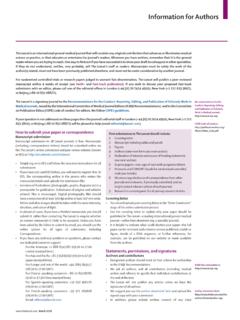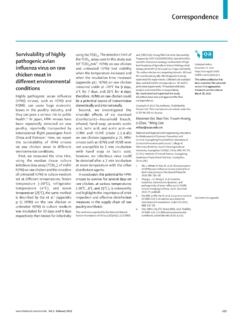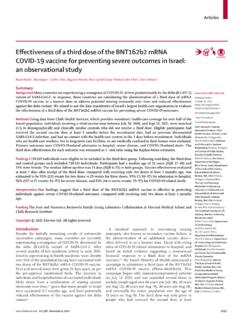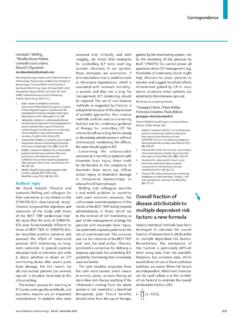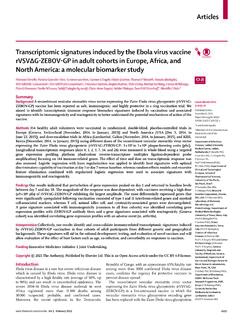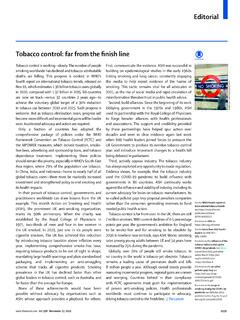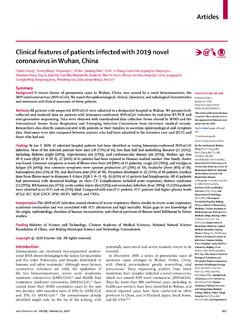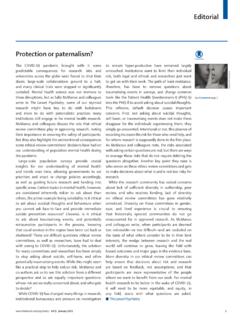Transcription of Reversible cerebral vasoconstriction syndrome - The Lancet
1 Review Reversible cerebral vasoconstriction syndrome Anne Ducros Lancet Neurol 2012; 11: 906 17 Recurrent thunderclap headaches, seizures, strokes, and non-aneurysmal subarachnoid haemorrhage can all reveal Emergency Headache Centre, Reversible cerebral vasoconstriction syndrome . This increasingly recognised syndrome is characterised by severe Head and Neck Clinic, headaches, with or without other symptoms, and segmental constriction of cerebral arteries that resolves within Lariboisi re Hospital, Paris, 3 months. Reversible cerebral vasoconstriction syndrome is supposedly due to a transient disturbance in the control France (A Ducros MD). of cerebrovascular tone. More than half the cases occur post partum or after exposure to adrenergic or serotonergic Correspondence to: Dr Anne Ducros, Urgences drugs. Manifestations have a uniphasic course, and vary from pure cephalalgic forms to rare catastrophic forms C phal es, H pital Lariboisi re, associated with several haemorrhagic and ischaemic strokes, brain oedema, and death.
2 Diagnosis can be hampered 2 rue Ambroise Par , 75475 Paris by the dynamic nature of clinicoradiological features. Stroke can occur a few days after initial normal imaging, and Cedex 10, France cerebral vasoconstriction is at a maximum on angiograms 2 3 weeks after clinical onset. The calcium channel blocker nimodipine seems to reduce thunderclap headaches within 48 h of administration, but has no proven e ect on haemorrhagic and ischaemic complications. Introduction Epidemiology Reversible cerebral vasoconstriction syndrome (RCVS) is RCVS has been reported in people aged from 10 to characterised by severe headaches, with or without other 76 years,7,25,26 but occurrence peaks at around 42 years and acute neurological symptoms, and di use segmental con- the syndrome is more common in women than in ,7,9. striction of cerebral arteries that resolves spontaneously Incidence is unknown, but the syndrome does not seem within 3 ,2 Manifestations are attributed to a to be especially rare the rst large series5 included transient disturbance of the regulation of cerebral arterial 67 patients who presented to the same institution during tone.
3 Thunderclap headache severe pain peaking in 3 years. Cases have been reported on every continent, and seconds is usually the rst symptom and typically recurs three large series from Asia, Europe, and North America for 1 2 5 Ischaemic and haemorrhagic stroke are have shown the broad range of presentations, from the major complications of the 9 In 2007, common benign to rare lethal forms (table).7 9 Many Calabrese and colleagues2 proposed the name RCVS and a characteristics of both RCVS and the patients studied set of diagnostic criteria to regroup all similar cases that di er between these large series, but whether these had been reported since the 1970s under several other di erences are due to ethnic factors or recruitment biases names (panel 1).10,11,13 23 Since then, large case series of the is unknown. syndrome have been ,7 9,24 In this Review, I. focus on the clinical and radiological features of RCVS. I Clinical features describe the clinical heterogeneity of the syndrome , Clinical manifestations typically follow an acute and self- appropriate investigations, and approaches to diagnosis limiting course without new symptoms after 1 (including possible di erential diagnoses) and manage- Headache is the main symptom and often remains the ment.
4 I aim to show that, although the pathological only manifestation of RCVS (table).5 Onset is acute with process is unknown and no speci c diagnostic test or thunderclap headache extreme head pain peaking in proven treatment is available, diagnosis is easy and an less than 1 min, mimicking that of a ruptured important step in the care of patients with RCVS. ,13 Screaming, crying, agitation, confusion, and collapse are common because of the excruciating pain. Typical headache is bilateral (although it can be Panel 1: Previous names for Reversible cerebral unilateral), with posterior onset followed by di use pain. vasoconstriction syndrome Nausea, vomiting, photophobia, and phonophobia fre- Isolated benign cerebral vasculitis10,11 quently occur. Acute benign cerebral angiopathy12 By contrast with the headaches associated with Reversible cerebral segmental vasoconstriction13,14 ruptured aneurysms, the severe pain of RCVS is short Call or Call-Fleming syndrome14 lived (usually lasting 1 3 h).
5 Thunderclap headaches CNS pseudovasculitis15 can be as short as a few minutes but cases lasting Benign angiopathy of the CNS16,17 several days have been reported. A single attack is Post-partum angiopathy18 possible, but usually patients have a mean of four Migraine angiitis19 attacks, during 1 4 ,5,24 Moderate headache Migrainous vasospasm11 frequently persists between exacerbations. Patients Primary thunderclap headache20 typically report at least one trigger eg, sexual activity cerebral vasculopathy21,22 (usually just before or at orgasm), straining during Vasospasm in fatal migrainous infarction23 defecation, stressful or emotional situations, physical exertion, coughing, sneezing, urination, bathing or 906 Vol 11 October 2012. Review showering, swimming, laughing, and sudden bending Neuroimaging ,4,5,7,8,25,27 30 The nal thunderclap headache occurs Brain scans of many patients with RCVS look healthy a mean of 7 8 days after onset of thunderclap headache, despite the presence of di use vasoconstriction on and all noteworthy headaches are generally gone concomitant cerebral angiograms.
6 Lesions are noted in 3 weeks after ,7,24 12 81% of patients, dependent on patterns of study In some cases, headache is more progressive or less recruitment (table, gure).5,7 9 Lesions include three severe than it is in typical cases, but the absence of types of stroke convexity subarachnoid haemorrhage, headache at onset of other symptoms is exceptional. intracerebral haemorrhage, and cerebral infarction . Associated neck pain should prompt investigations for and Reversible brain ,7,8,33,35 Chen and co- cervical artery ,31 Focal de cits, which can be workers7,24 used haemorrhage as an exclusion criterion transient or persistent, and seizures have been reported in their prospective study of RCVS, which precluded a in 8 43% and 1 17%, respectively, of the cases in the description of this manifestation. In the French series,8. three large series (table).7 9 Seizures can be inaugural, 65 of the 89 patients had headache as their only and recurrence is ,13,18,28,32 Transient focal de cits are symptom (eg, the purely cephalalgic form of RCVS), present in slightly more than 10% of patients, last from and MRI scans showed a localised convexity bleeding in 1 min to 4 h, and are most frequently visual, but sensory, 16 of 65 (25%) and posterior Reversible encephalopathy dysphasic, or motor de cits can also occur.
7 Most focal syndrome in 5 of 65 (8%). Signs of stroke were visible de cits have a sudden onset and are typical of those noted in transient ischaemic attacks, but they can mimic Chen et al7 (n=77) Ducros et al8 (n=89) Singhal et al9. a migraine aura with positive symptoms progressing (n=139). over a few Persistent de cits, including Recruitment Prospective, from a Prospective, from a Retrospective, from hemiplegia, aphasia, hemianopia, or cortical blindness, headache clinic single institution with an internal medicine suggest a ,9,13,17,30 an emergency department and a headache centre and stroke unit The results of physical examinations are usually a stroke unit normal, except when RCVS is associated with posterior Duration 2002 09 2004 08 1993 2009. Reversible encephalopathy syndrome in the setting of Mean age (range) 47 7 years (10 76) 43 2 years (19 70) 42 5 years (13 69). eclampsia, septic shock, or other severe predisposing Sex distribution (men:women) 1:8 6 1:2 2 1:4 3.
8 Disorders. A third of patients have surges in blood History of migraine 17% 27% *. pressure during acute headaches5,7,13 because of the pain, History of hypertension 25% 11% . the syndrome itself, or an associated disorder. Any precipitant for syndrome 8% 62% . Post partum 1% 13% 11%. Laboratory investigations vasoactive substances 3% 52% 42%. The results of blood counts, measurements of ESR and concentrations of serum electrolytes, and liver and renal Headaches at onset 100% 100% 95%. function tests are usually normal in patients with RCVS. Recurrent thunderclap 100% 91% 78%. A few patients have a transient in ammatory response, Any trigger for headaches 80% 75% . which might be due to the clinical situation preceding the Focal neurological de cit 8% 25% 43%. clinical onset of RCVS (eg, cold treated with nasal Seizures 1% 4% 17%. decongestants6 or skin rash treated with steroids13). Tests Blood pressure surge 46% 34% Some.
9 For angiitis, including measurements of rheumatoid Initial CT or MRI normal 80% 55%. factor, antinuclear and antineutrophil cytoplasmic Any abnormal CT or MRI 12% 37% 81%. antibodies, and tests for Lyme disease are generally Subarachnoid haemorrhage 0% 30% 34%. negative. Urinary concentrations of vanillylmandelic acid Intracerebral haemorrhage 0% 12% 20%. and 5-hydroxyindoleacetic acid should be measured to cerebral infarction 8% 6% 39%. exclude a diagnosis of ,33 Serum Posterior Reversible encephalopathy 9% 8% 38%. and urine toxicology screens should be done to check for syndrome drug CSF analysis available 18% 88% 82%. Slight abnormalities of CSF are reported in 0 60% of Protein concentration >60 mg/dL 0% 12% 16%. patients eg, an excess of white blood cells (5 35 per L), 5 10 white blood cells per L .. 17% 12%. red blood cells with or without visible subarachnoid >10 white blood cells per L 0% 8% 3%. blood on an MRI scan,5,8 and increased protein Death 0% 0% 2%.
10 Concentrations of as much as 100 ,5,9,13 If the white Persistent focal neurological de cit 3% 6% 20%. blood cell count exceeds 10 cells per L or the protein from stroke at follow-up concentration exceeds 80 mg/dL, or if both measures are *40% of patients had a history of headaches. Percentages refer to female patients only. No speci c data were exceeded, analysis of CSF should be repeated after a few reported. Haemorrhage was an exclusion criterion in this series. weeks to ensure that concentrations have returned to Table: Large case series of Reversible cerebral vasoconstriction syndrome normal. Vol 11 October 2012 907. Review Very rarely, a more di use haemorrhage occurs A C. that includes the perimesencephalic Convexity subarachnoid haemorrhage is usually diagnosed within the rst week of headache onset, sometimes after an initial normal About 50% of cases are associated with another type of stroke, either at onset or later in the course of the disorder.
